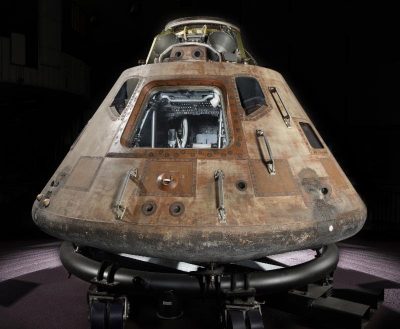SEATTLE, WA (press release) –The Smithsonian Institution announced at a ceremony today that the Apollo 11 command module Columbia–the only portion of the historic spacecraft to complete the first mission to land a man on the moon and safely return him to Earth–will be exhibited at The Museum of Flight on the fiftieth anniversary of its Moon flight. The iconic capsule will leave the Smithsonian’s National Air and Space Museum for the first time in 46 years for the two-year traveling exhibition Destination Moon: The Apollo 11 Mission.

The Museum of Flight will be one of four destinations for Destination Moon: The Apollo 11 Mission during its national tour beginning in April 2018. The exhibition comes to The Museum of Flight in Seattle March 16-Sept. 2, 2019, making it the last stop–and only West Coast destination–of the tour. Following Seattle, the Apollo 11 command module will return to Washington, D.C., where it will be part of a new gallery opening in 2020 at the National Air and Space Museum.
Past adventures to the Moon begin this year at The Museum of Flight in May 20, with the opening of Apollo. Using rare artifacts from the Museum of Flight’s collection, this major exhibit will immerse visitors into the early story of spaceflight and into the Apollo Moon missions. Apollo will will be modified with the opening of the Destination Moon: The Apollo 11 Mission.
About Destination Moon: The Apollo 11 Mission
Through original Apollo 11-flown objects, models, videos and interactives, visitors will learn about the historic journey of the Apollo 11 crew-Neil Armstrong, Michael Collins and Buzz Aldrin. Destination Moon: The Apollo 11 Mission will include an interactive 3-D tour, created from high-resolution scans of Columbia performed at the Smithsonian in spring 2016. The interactives will allow visitors to explore the entire craft including its intricate interior, an interior that has been inaccessible to the public until now.
On July 24, 1969, Apollo 11 met President John F. Kennedy’s 1961 challenge to ‘land a man on the moon and return him safely to the Earth.’ The exhibition will explore what led the United States to accept this challenge and how the resulting 953,054-mile voyage to the moon and back was accomplished just eight years after the program was authorized. Destination Moon: The Apollo 11 Mission will examine the mission and shed a light on some of the more than 400,000 people employed in NASA programs who worked through the trials, tragedies and triumphs of the 20 missions from 1961 to 1969 before Apollo 11.
The tour will mark the first time Columbia will leave the National Air and Space Museum since the museum opened to the public in 1976. Before entering the collection, the command module traveled on a 50-state tour throughout 1970 and 1971 covering more than 26,000 miles. It then went on display in the Smithsonian’s Arts and Industries Building before the current National Air and Space Museum was built on the National Mall.
Destination Moon: The Apollo 11 Mission is made possible by the support of Jeff and Mackenzie Bezos, Joe Clark, Bruce R. McCaw Family Foundation, the Charles and Lisa Simonyi Fund for Arts and Sciences, John and Susann Norton, and Gregory D. and Jennifer Walston Johnson. Transportation services for Destination Moon are provided by FedEx.
The traveling exhibition previews part of a new gallery opening at the National Air and Space Museum in Washington, D.C., which is slated to open in 2020. Destination Moon at the museum will tell the story of human exploration of the moon, from ancient dreams to the Apollo program to the missions happening right now.
